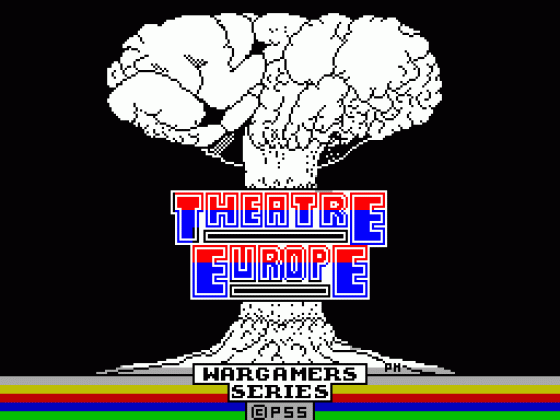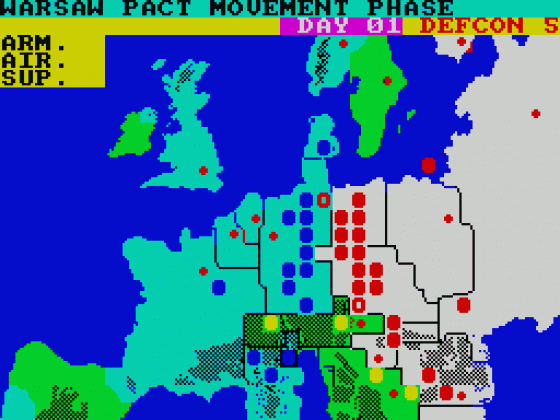
Crash
 1st July 1986
1st July 1986
Categories: Review: Software
Author: Sean Masterson
Publisher: PSS
Machine: Spectrum 48K
Published in Crash #30
Theatre Europe
Theatre Europe. The very mention of the term conjures images of CND banners, argumentative politicians and a barren, nightmarish wasteland where life as we know it has ceased to be. This is what this game is about: the grim reality of a nuclear holocaust. Before those of you with strong feelings start to argue the points of mixing the horrific consequences of war and computer games, the object of Theatre Europe is to avoid any sort of nuclear confrontation - or at least to demonstrate how such a conflict could never be won.
The game offers options for a single player to take on the computer, a two payer head-to-head or a demo version where the computer plays itself. The latter option is very interesting and quite frightening. If you buy this game I strongly recommend you sit down and watch what happens!
Although this is essentially a war game it uses a series of screens to depict the action in a very atmospheric way. There is also an arcade action sequence which may be incorporated by shoot em up fans or ignored by serious wargamers. If the arcade option is chosen, you are asked to select a battle once combat is under way. Move the cursor over the desired unit, and a picture of a plain with a city in the background is presented with aeroplanes, helicopters and tanks moving about. A target cursor is placed under your control in similar style to Missile Command and this is used to destroy the enemy. At the bottom the screen icons depict different kinds of weaponry. It's a good feature to have, as the process of co-ordinating your defences becomes more complex and logical.

Your performance in the arcade sequence plays a major part in the game, as it is taken into consideration in arriving at a strength factor that decides the fate of forces elsewhere: doing badly in this phase results in severe losses all round.
Once you've decided whether or not to take the action screens, the forces you would like to command need to be chosen, either the Warsaw Pact or NATO. Special units are made available to the Warsaw Pact: the 1st Airborne Army which can be flown directly behind enemy lines, and the 1st Amphibious Army which can move over the sea to a tactical attack point. Next, one of the three levels of play must be chosen. Level One plays a totally conventional war game and, unless provoked, does not use the nuclear or chemical option, whilst Levels Two and Three see the computer using nuclear and chemical options to prevent you winning the game. Level three plays a highly intelligent and unpredictable game, and nuclear escalation on this level is usually enormous.
With the level selected, a detailed map of Europe and Western Russia (including Moscow) is presented showing mountain ranges, capital cities, country borders and all the armed forces of both sides. It is time to move your units. Place the cursor over the desired unit, press fire and move the cursor the place where you want the unit to end up. You can only move one character space at a time and the unit moves as soon as you press the fire button again.
Once all unit moves have been decided, the attack phase follows. This time, position the cursor over the enemy unit you wish to attack. Any amount of your units can attack a single enemy army, but once a unit is sent into battle it cannot be halted until the phase is over.
When the attacking moves have been set up, the ENTER key starts the fighting. If the action screen option has been chosen the computer asks the player to select a battle, whereupon the on screen action happens. If the action screens aren't operational, the battle is decided on merits of air superiority, supplies and armament.
After the battle, units can be rebuilt with somewhat scant supplies. First, a quantity of armament supplies can be issued to the more desperate forces using the cursor to select units and the fire button to indicate the quantity of supplies to be allocated. Similarly, air support supplies may be allocated. The rebuilding schedule needs to be planned carefully - once a supply is sent it cannot be reclaimed.
After rebuilding you move onto the air phase. This is to determine how to use your air command during the next turn. Reserve air units can be accessed, but they are very limited and have to be used sensibly. Several options for allocating air reserves are available, some essential and some tactical. Essential options are air power (the most important), counter air strikes and reconnaissance. Other options include interdiction, assault breakers, deep strike and iron snake.
Counter air strikes are attacks on enemy airfields and bases; interdiction is where planes are sent behind enemy lines to attack enemy supply and movement networks. Care has to be taken when using this option since it carries the risk of setting off a retaliatory nuclear strike. The other three are, respectively, an attack on a single unit, a strike into enemy territory, and an attack on railways to disable enemy reinforcements.
The most controversial part of the program involves the use of chemical and nuclear weapons. There is an option - Special Mission - which allows the player to set off a strategic chemical or nuclear launch. A chemical launch is automatically targeted on an enemy supply city. A special readout gives you the details and expected results, and reports on the outcome of the attack. This mission carries the risk of an enemy nuclear response.
A strategic nuclear attack involves some pretty tense moments the first few times it's used. When you first switch to nuclear mode you are given 30 seconds to ring a phone number and obtain a special authorisation code. This is a real number, contactable 24 hours a day.
The code number gives direct control over all targeting and warheads. There are three separate settings: Standby, to which the game reverts if you decide against a launch; Strategic Launch, where a single nuclear strike can be targeted ; and finally Fire-Plan, a full-scale strike. Targeting a single nuclear or chemical launch is alarmingly simple. You are given control of a cursor to position over the desired target. Press fire and the rest is done automatically.
When under enemy nuclear attack, the launch is detected and a target cursor follows the progress of the enemy missile. If your Reflex system is operative, your forces automatically launch a strike of similar size. There is nothing you can do but watch the targets being destroyed in a sequence of graphic screens.
As the game is played, it becomes increasingly obvious that the war cannot be won with nuclear weapons.
This is a brilliant game which offers more than the usual run-of-the-mill war game via its tense action screens and gripping atmosphere. The arcade sequences mean that arcade players could well become interested, and the simplistic playability means that novice war gamers can get into this with ease. Wargame purists might become rather bored by the rather superficial gameplay and the action screens, but it's well worth buying if you do have an interest in wargaming - and the future.
Other Reviews Of Theatre Europe For The Spectrum 48K
Theatre Europe (PSS)
A review by Gwyn Hughes (Your Sinclair)
Theatre Europe (PSS)
A review
Theatre Europe (PSS)
A review by John Gilbert (Sinclair User)
Theatre Europe (PSS)
A review
Theatre Europe (PSS)
A review
Other Spectrum 48K Game Reviews By Sean Masterson
Scores
Spectrum 48K Version| Presentation | 86% |
| Rules | 87% |
| Playability | 81% |
| Graphics | 83% |
| Authenticity | 89% |
| Opponent | 88% |
| Value For Money | 85% |
| Overall | 84% |









